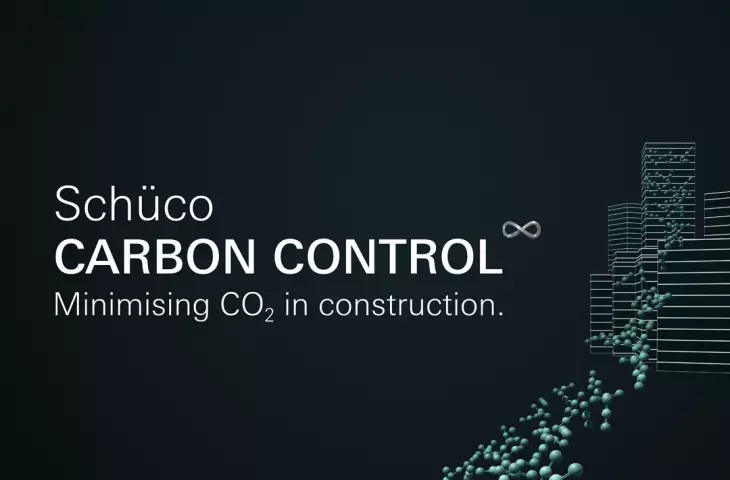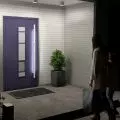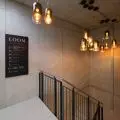As early as January 1, 2027, the value of the carbon footprint of buildings is to be shown in energy certificates, which will translate into their market value. The attractiveness of an investment in the eyes of potential customers can be increased by using renewable and certified materials with reduced CO₂ content. Schüco's Carbon Control program enables efficient planning and implementation of buildings with an optimal carbon balance.
The carbon footprint of a building is reduced by appropriately selected materials and technologies
© Schüco
Today, every building that is commissioned, sold or rented must have an energy certificate specifying its energy demand and CO₂ emissions. An amendment to the EPBD, voted on by the European Parliament in March, also makes it mandatory to show a Global Warming Potential (GWP) indicator showing how much a building contributes to CO₂ emissions over its entire life cycle. The climate change impact of an investment will thus soon be assessed not only on the basis of the operation phase, but also the extraction and production of materials, construction, maintenance and demolition, and even the storage and disposal of components. The changes are to take effect as early as January 1, 2027 for new buildings with a floor area of more than 2,000 m², and as of January 2030 for all new buildings. As part of the Carbon Control program, Schüco currently offers up to 76 Cradle to Cradle-certified aluminum window, door and facade systems and profiles with areduced CO₂ content, which have received environmental product declarations (EPDs) specifying their GWP coefficients as CO₂e/kg equivalents, as well as innovative aluminum-wood hybrid systems. The impact of using individual solutions on a building's carbon balance can be checked in the SchüCal 3D calculation program.
Two new Schüco aluminum varieties with reduced CO₂ have received EPD declarations.
© Schüco
Aluminum with reduced CO₂ content.
A huge advantage of aluminum from a sustainability perspective is its recyclability and recyclability. Despite this, the primary carbon footprint of this material can be very high if the energy used in the smelting process is produced by burning coal, for example. Aluminum is being used on an increasingly large scale today for, among other things, glazed facades, windows or doors in energy-efficient buildings. That's why, in addition to standard aluminum, Schüco has made two new varieties available: Low Carbon (LC), with low carbon content, and Ultra Low Carbon (ULC), with very low carbon content. They have obtained EPD environmental declarations containing information on their impact on the greenhouse effect. An analysis by the Berlin Institute for Building and the Environment (Institut Bauen und Umwelt e.V.) showed that the GWP value of the LC grade is 4.47 kg CO₂e/kg, while that of ULC is only 2.27 kg CO₂e/kg. In addition, ULC aluminum contains at least 75% recycled material. The impact of using the different varieties on the building's carbon balance and production costs can be checked in the SchüCal 3D calculation software. The program calculates carbon dioxide content as CO₂e equivalent with high accuracy and allows for the issuance of EPD environmental declarations.
Cradle to cradle environmental systems
The Cradle to Cradle concept postulates designing products so that they can circulate in closed process circuits without loss of quality. The construction industry is responsible for consuming 50% of the world's material resources, and therefore represents a huge potential for introducing the circular economy. Schüco is in a leading position in the C2C program, as its portfolio currently includes as many as 61 systems certified at the silver standard and 15 at the bronze level. The silver-level certified group includes 36 window systems, 13 mullion and transom façade systems, 7 door systems, 2 solar control systems and 3 fire protection systems. Especially noteworthy are the aluminum and wood solutions with an ultra-modern design. They are not only extremely ecological due to the use of renewable materials, but also allow to create a unique architectural atmosphere. The Schüco AWS WoodDesign hybrid window system combines a minimalist aluminum block window design with a concealed sash with oak wood surfaces on the inside. Schüco AWS WoodDesign windows are available in two versions with installation depths of 75 and 90 mm and front frame widths of 67 and 77 mm, respectively.
An office building with an overlay facade on a Schüco AOC.TI wood structure with a minimum profile face width
© Schüco
The sustainability of the system was confirmed with a silver C2C certification. Sustainable buildings complying with the demanding rules of LEED or BREEAM certification are increasingly using striking, currently fashionable wooden load-bearing structures. These can be realized using the modern Schüco AOC TI overlay structure, which provides a wide range of possibilities for the design and realization of skylights and large-scale vertical facades on a wood substructure. The innovative aluminum system with its high load-bearing capacity and small profile front widths allows transparent structures with sophisticated design and excellent thermal insulation even at the passive level of Uf ≥ 0.67 W/m2K for the frame alone.
Cross-section through an overlay structure on a Schüco AOC 75 TI timber substructure
© Schüco
Thanks to special fastener and bracket solutions, the wood-aluminum facade carries very high loads with large-format glazing weighing up to 1,100 kg. Depending on static and thermal protection needs, you can choose a variant with a front width of 50, 60 or 75 mm. The system has received Cradle to Cradle silver certification, which confirms its sustainability throughout its life cycle, from production to operation to recycling.
Schüco AWS Wood Design aluminum-wood windows
© Schüco































